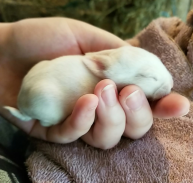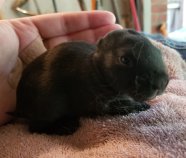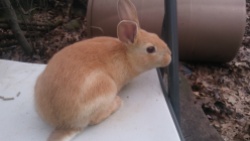It’s been a long season. Here’s some pictures from this year I haven’t gotten up yet!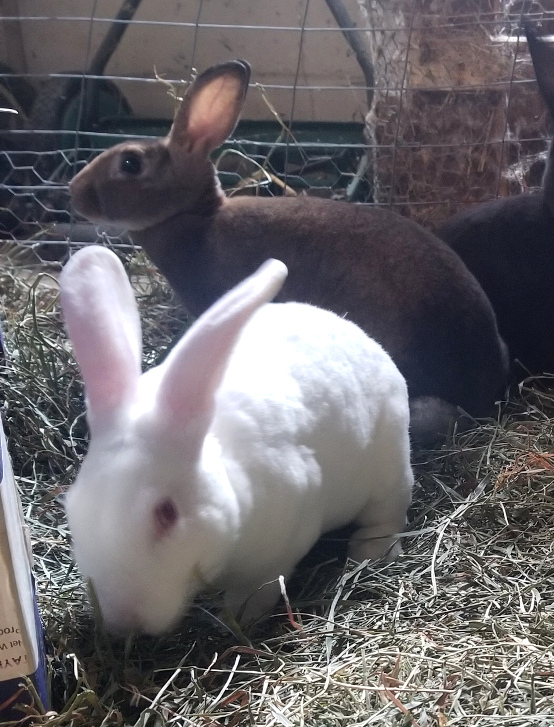
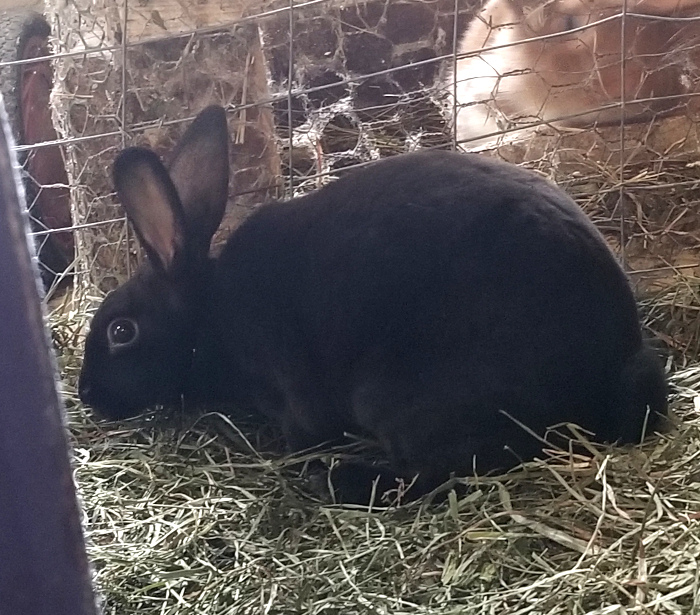 Pictures of Donuts kits, now 13 weeks old.
Pictures of Donuts kits, now 13 weeks old.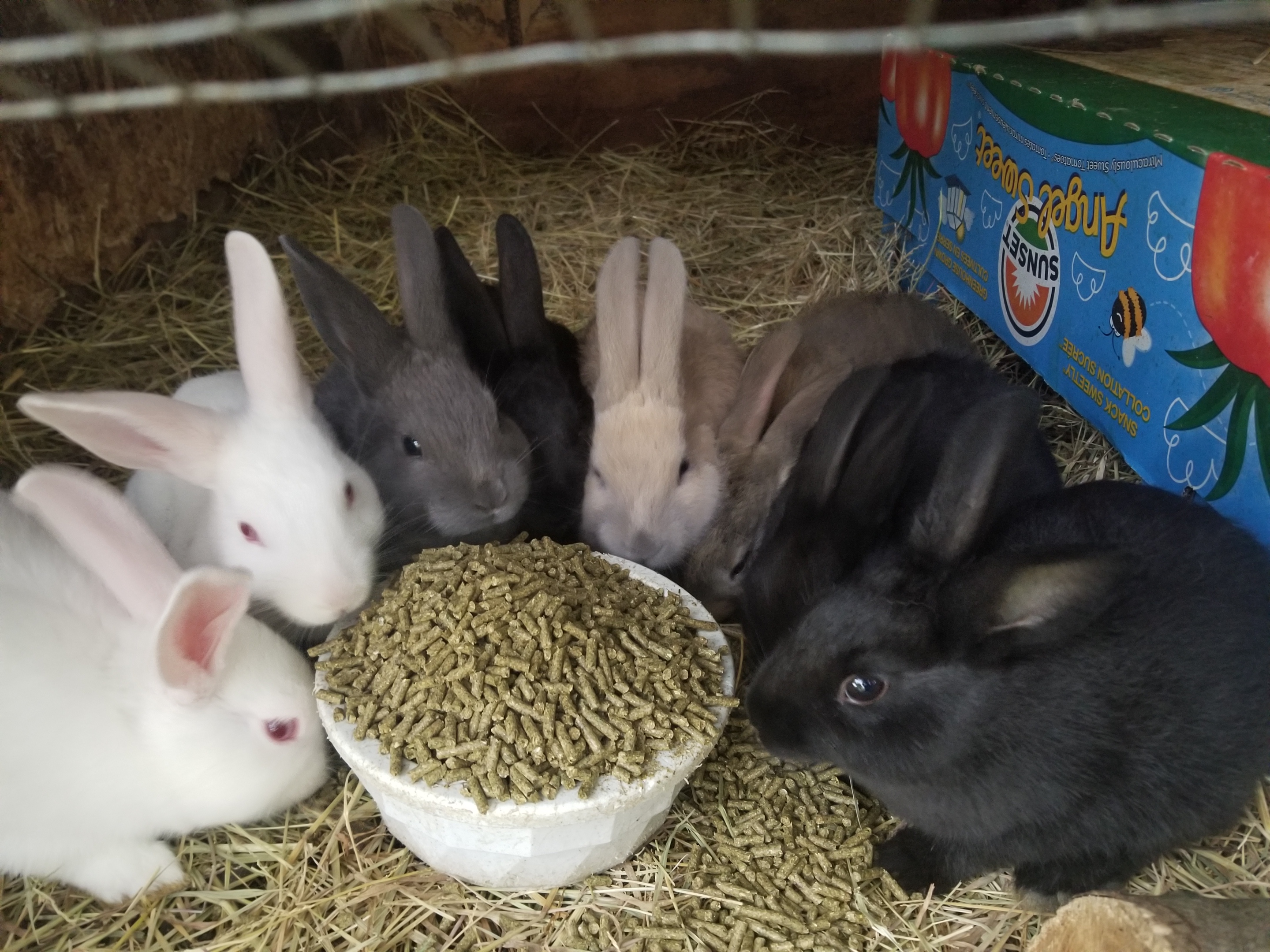 Picture of Whites kits, now 8 weeks. The pretty pearlescent one turned out to be a blue tort.
Picture of Whites kits, now 8 weeks. The pretty pearlescent one turned out to be a blue tort.
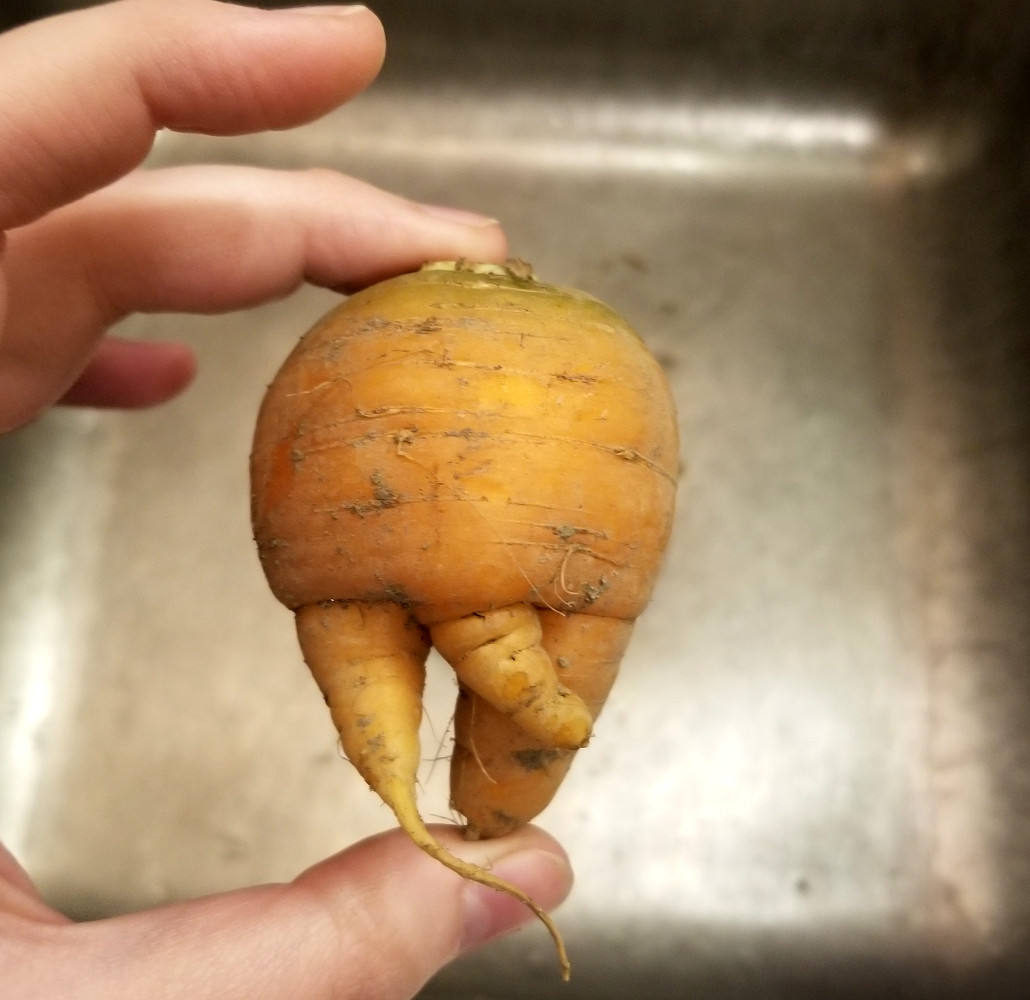 Some very ordinary carrots we grey this year. ( ͡° ͜ʖ ͡°)( ͡° ͜ʖ ͡°)( ͡° ͜ʖ ͡°)
Some very ordinary carrots we grey this year. ( ͡° ͜ʖ ͡°)( ͡° ͜ʖ ͡°)( ͡° ͜ʖ ͡°)
Honeynut, Brulee and baby blue hubbard squashes that we planted, and some mini pumpkins that volunteered.

This years pullets, enjoying some tractor time. All of them turned out to lay blue/green eggs!
Some chicks, looking cute in the brooder. These ones are 10 weeks old now!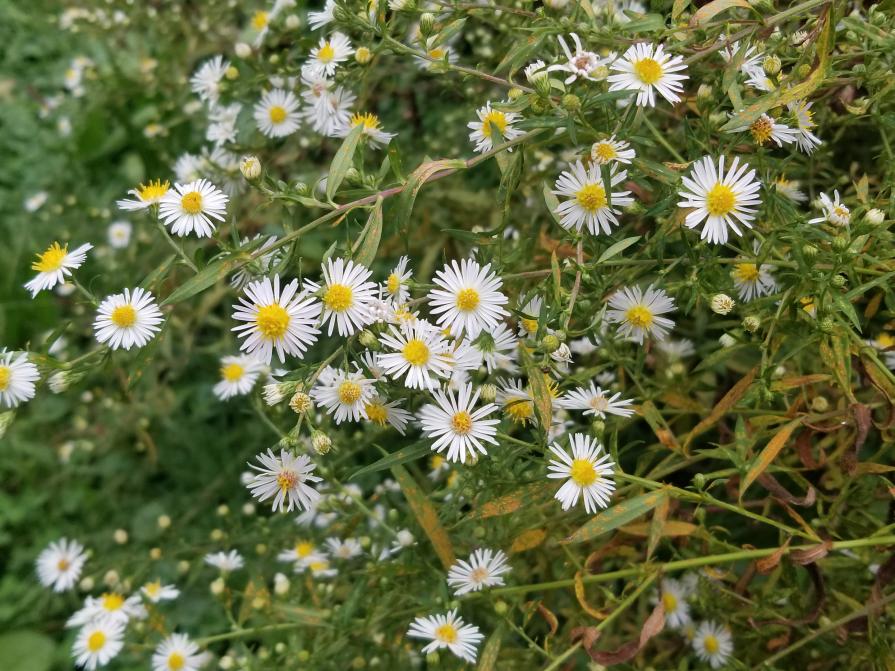 Asters, our last flowers of the year, in full bloom. These flowers get COVERED in bees.
Asters, our last flowers of the year, in full bloom. These flowers get COVERED in bees.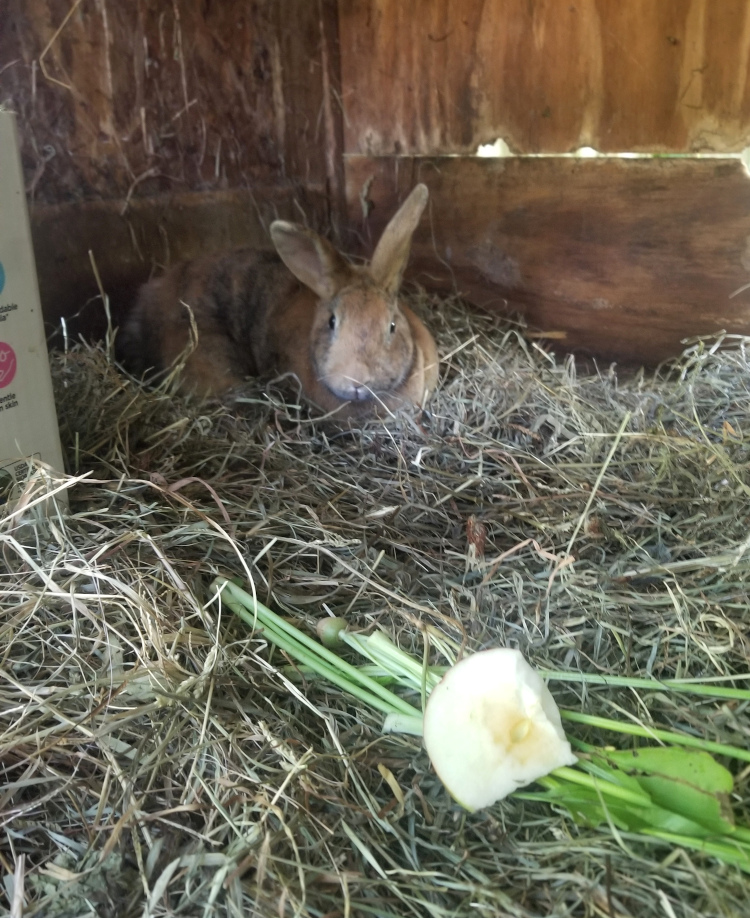
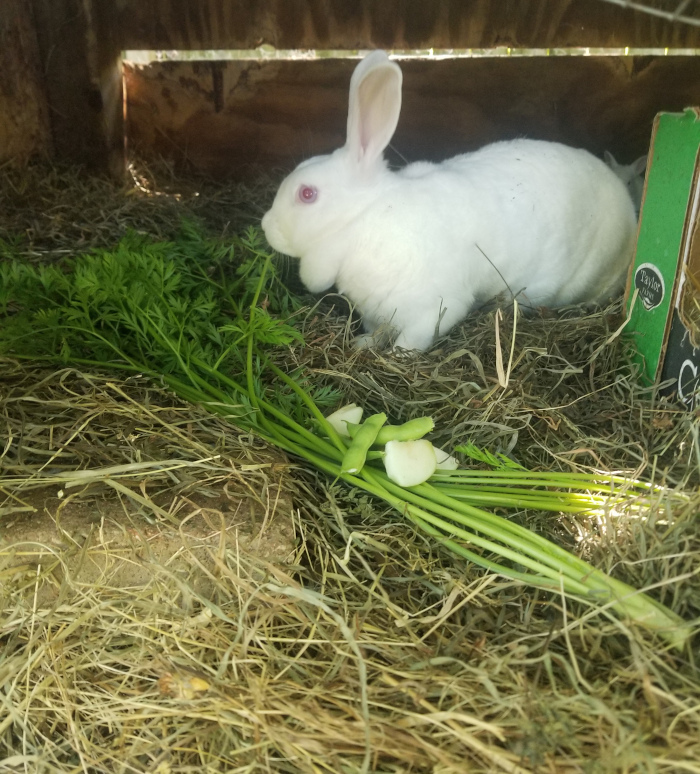 White and stripes enjoying snacks on Mabon! Apples, carrot tops and green beans.
White and stripes enjoying snacks on Mabon! Apples, carrot tops and green beans.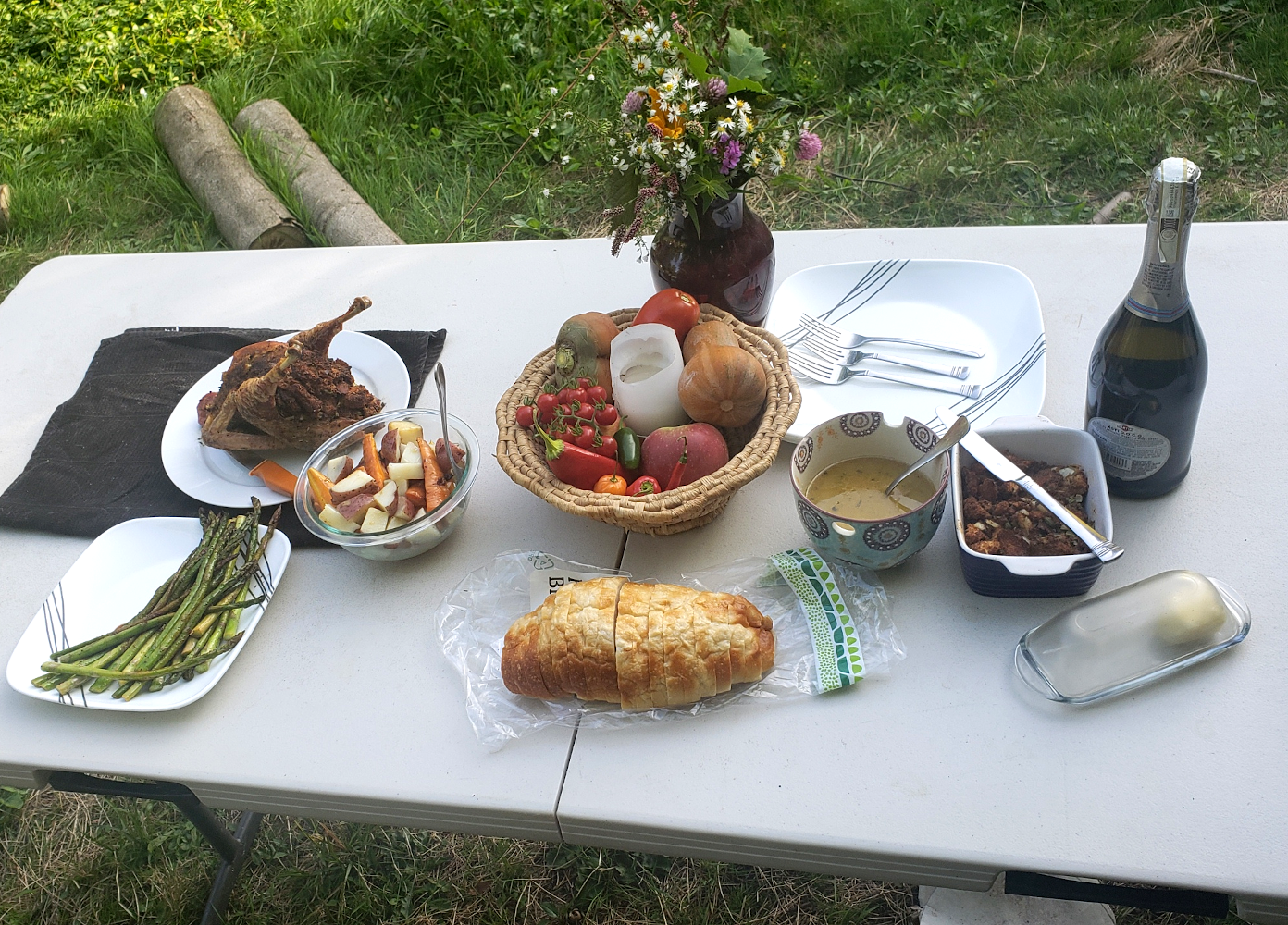
Our Mabon dinner, looking beautiful in the evening light.
That’s all for now!
A good kind of busy
It will come as no surprise to anyone that it’s harvest time on the farm. It’s a deeply busy time of year. Exhausting work, really. Our first wave of tomatoes finally hit hard, so we washed and cut for hours and then simmered for hours more to cook out the water.
Our first wave of tomatoes finally hit hard, so we washed and cut for hours and then simmered for hours more to cook out the water.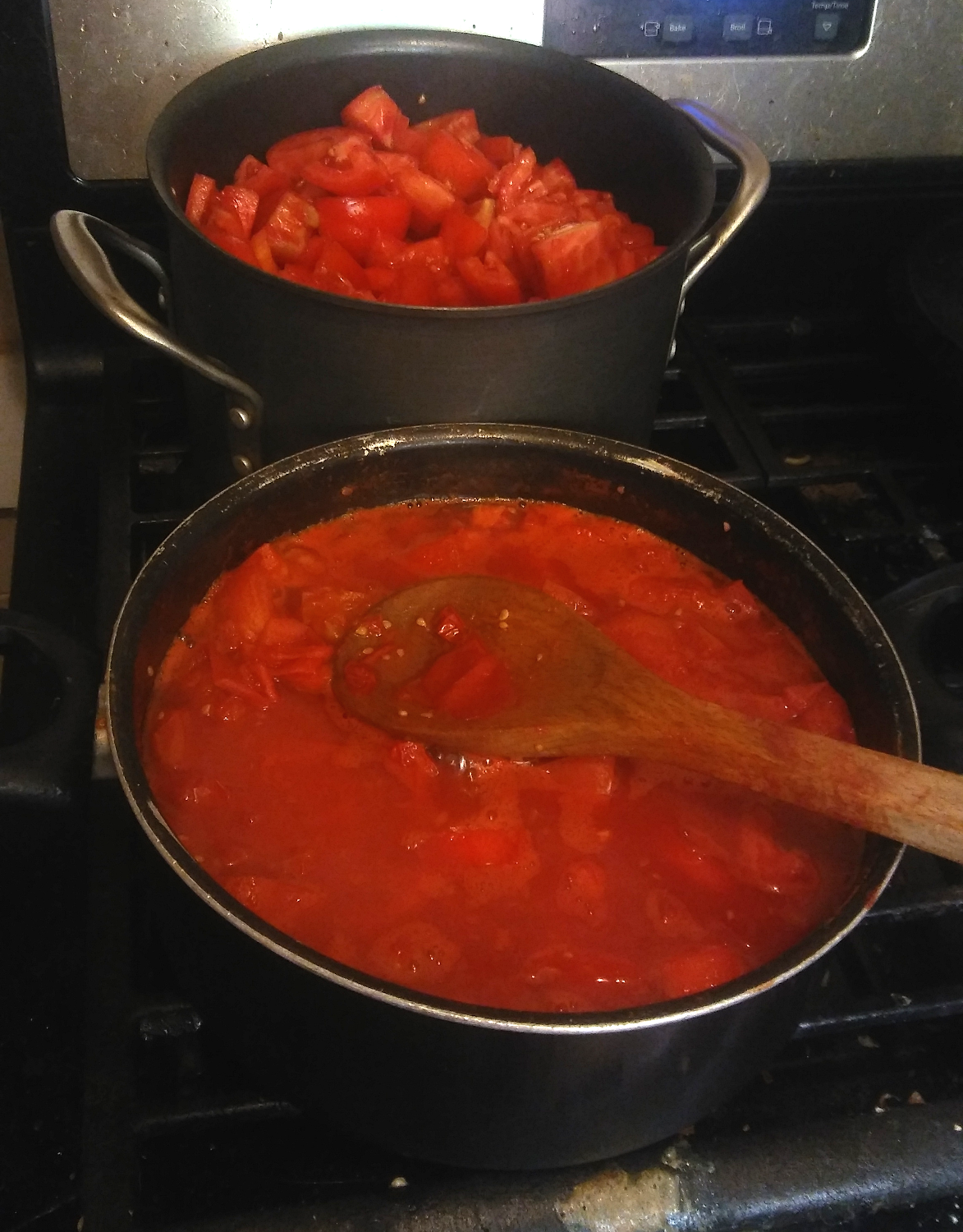 Then came the milling, and cooking out the water even more. Our milling is done with a small hand mill. It removes all the skin and seeds well but it does take a bit of effort.
Then came the milling, and cooking out the water even more. Our milling is done with a small hand mill. It removes all the skin and seeds well but it does take a bit of effort.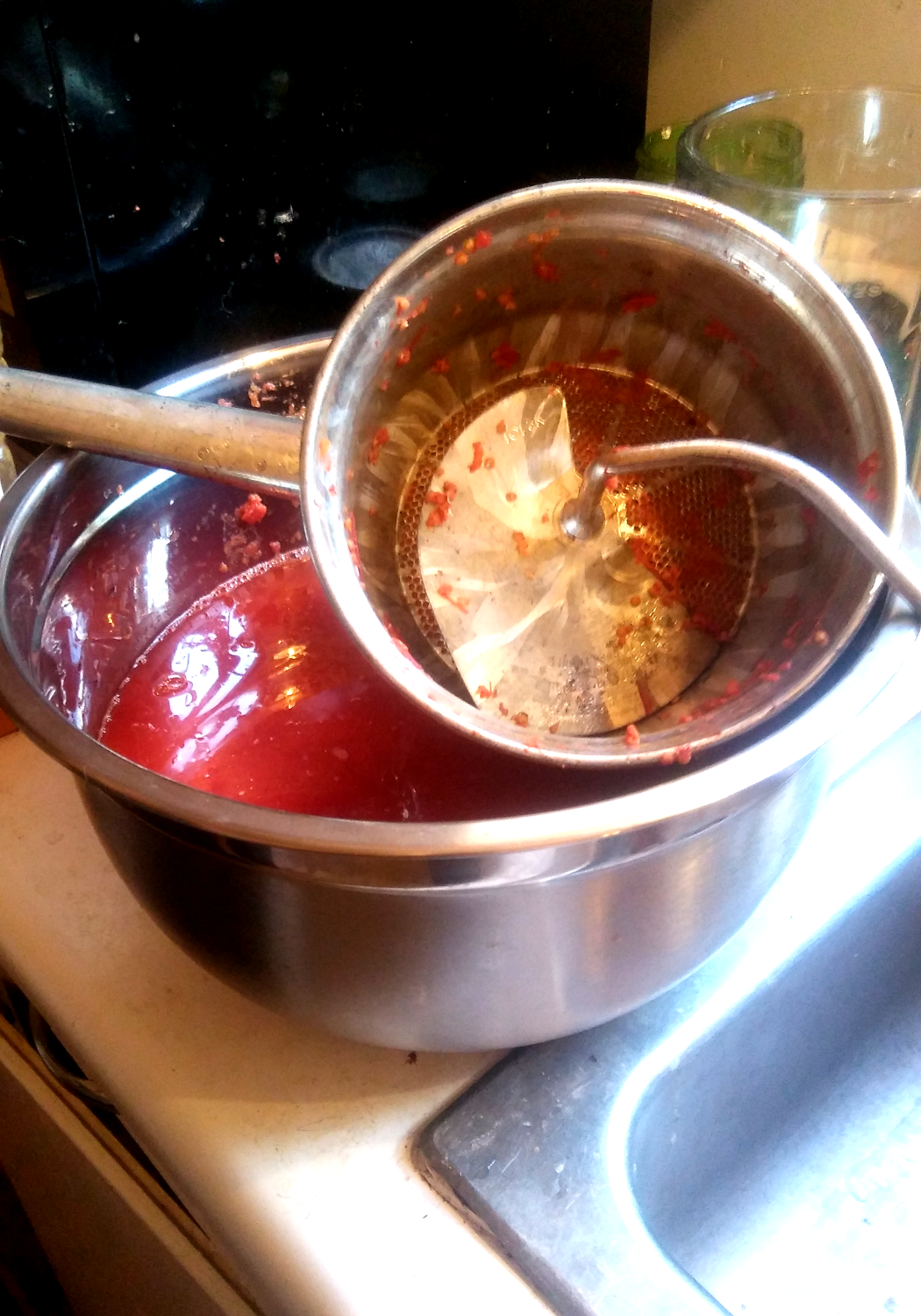 Then the skins, seeds, and any last bits of tomato go into the dehydrator. This will make tomato powder that we can use in place of tomato paste or we can use as a seasoning. It really brings most BBQ potato chip seasoning recipes to a whole new level.
Then the skins, seeds, and any last bits of tomato go into the dehydrator. This will make tomato powder that we can use in place of tomato paste or we can use as a seasoning. It really brings most BBQ potato chip seasoning recipes to a whole new level. Lastly, we have a bit of an assembly line. With the tomato sauce boiling, the lids and rings boiled, we fill our jars; first with hot steamy water from the tap so they are not shocked by the temperature change. Then we dump that out and fill them to the brim with boiling water to sterilize. One at a time we dump the boiling water out, drop in 1/4tsp citric acid, pop in the canning funnel, fill the jar, wipe the rim, then hand tighten the lids before popping them into the canner. This part goes quickly, with each person in the household helping with a different part of the process, so I don’t have any pictures of it. We used a water bath canning method but you could also pressure can.
Lastly, we have a bit of an assembly line. With the tomato sauce boiling, the lids and rings boiled, we fill our jars; first with hot steamy water from the tap so they are not shocked by the temperature change. Then we dump that out and fill them to the brim with boiling water to sterilize. One at a time we dump the boiling water out, drop in 1/4tsp citric acid, pop in the canning funnel, fill the jar, wipe the rim, then hand tighten the lids before popping them into the canner. This part goes quickly, with each person in the household helping with a different part of the process, so I don’t have any pictures of it. We used a water bath canning method but you could also pressure can.
And then the canning is done! We made 17 pint jars of sauce but only canned 15. We will use the other two over the next 2 weeks and they will be stored in the fridge. They have nothing in them but tomatoes and citric acid (to preserve freshness). Two ingredients. Perfect.
We put the last plants in the ground – a small crop of peas we’re not expecting much out of. these were the peas from the pods that we saved that looked ugly – like they had gotten mold on them or developed wrong. The culls. If we get a crop of peas from them, great. If not, they will rot in the ground and feed the worms. And that’s not so bad in the end. G pointed out that our season started and ended with peas. It was a happy moment for me. It feels appropriate, like the start and end of the season being marked by a cyclical event.
We also have a lot of babies on the homestead right now. We have several kits from our castor doe, Donut, growing up big and strong. (Unfortunately the runt did not survive the litter leaving the nest box, but the rest are well.) These two are harlequins. One – the girl – we believe is torted, which is not ideal but we can make due.
We have a fresh batch of six baby chicks hatched under one of our broody girls. And another incubation under a broody well under way.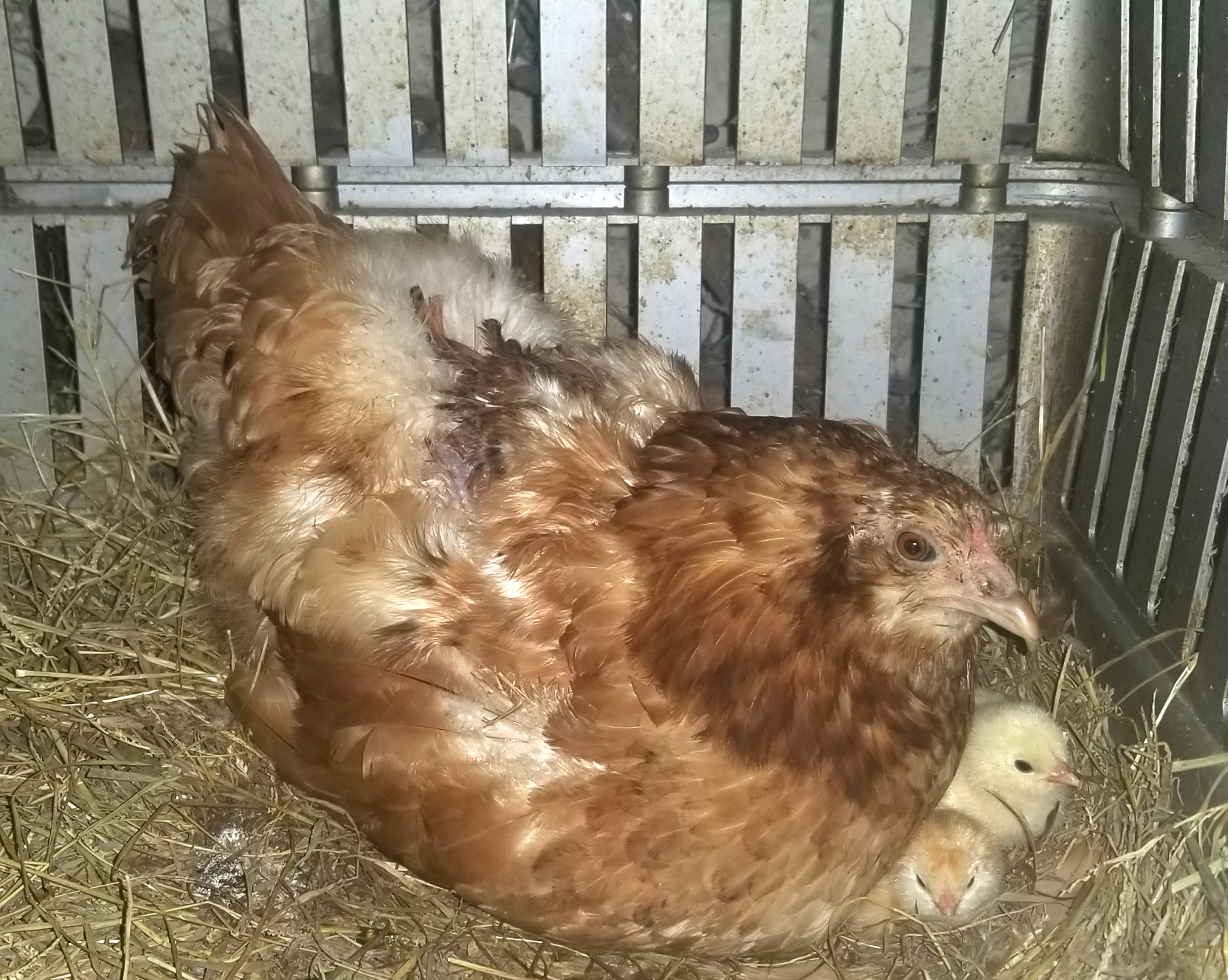 And a lovely litter of nine from our New Zealand White crossed with a rex.
And a lovely litter of nine from our New Zealand White crossed with a rex.
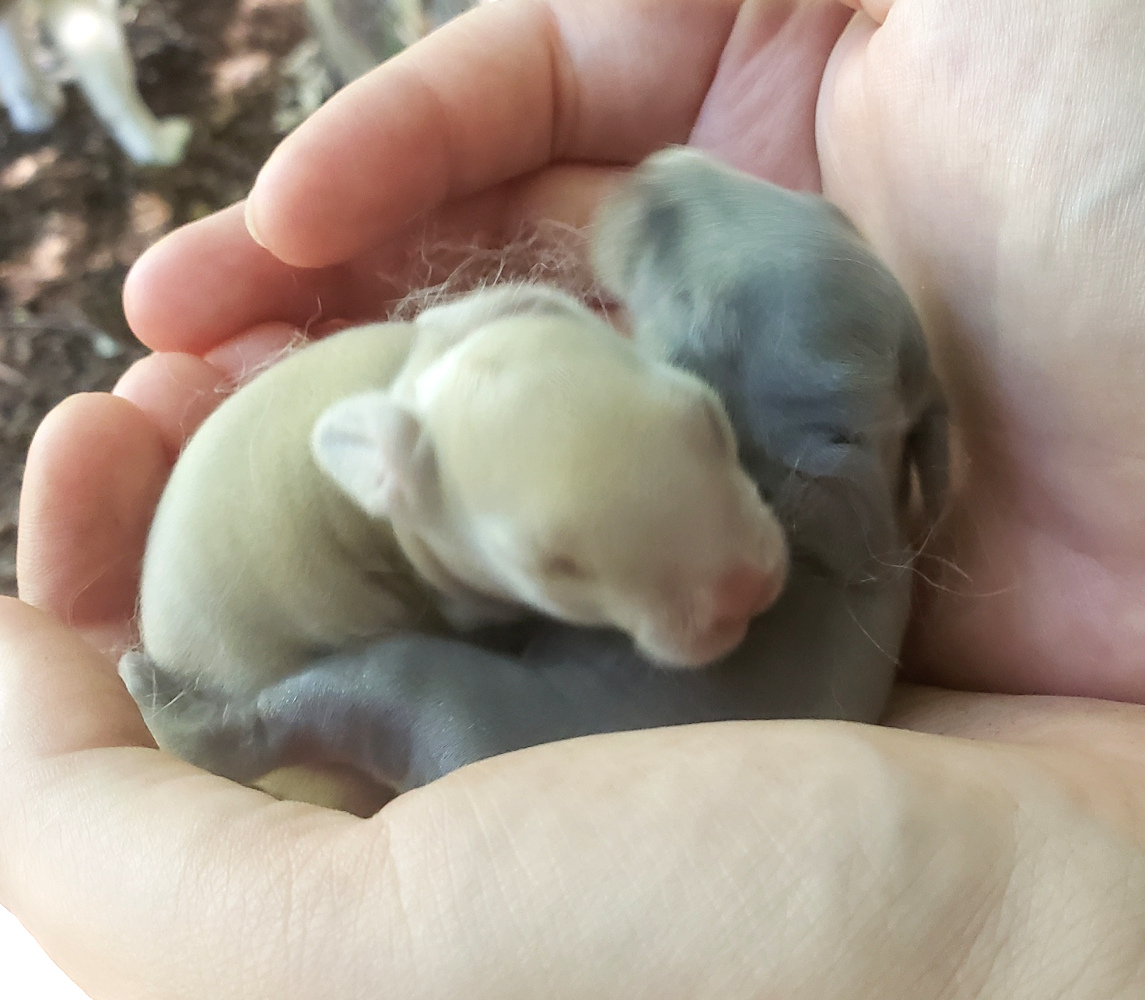
Look at the lovely, pearlescent and dilute colors on these two. They absolutely shine. Unfortunately, I believe the lighter one might be a self tort, beautiful but not very useful for my needs. I’m holding out hope it’s secretly somehow a lilac.
So as you can see, it’s the busy season. Harvests are in full swing, preservation is taking place, and the animals are having their last babies in warm weather. Before we know it, the chickens will stop laying for their molt, and may not start again until spring, and the rabbits will build their nests deeper and thicker, and the dogs will spend their days running in the snow. But until then, every day will be work. Our next task will be hot sauce, then more tomatoes, then more chicks and rabbits until the season finally ends. It’s exhausting, but busy in a good way.
I hope you’re staying busy in a good way too.
Baby Bunnies
This is Donuts litter, born just about 10 days ago. They started as 11. Ultimately only 8 remain and that’s taken some intervention – not too surprising or shabby for a first time mom though. They’re a colorful bunch. Can you spot the tiny one that almost didn’t make it? It’s hard to believe they’re all the same litter.
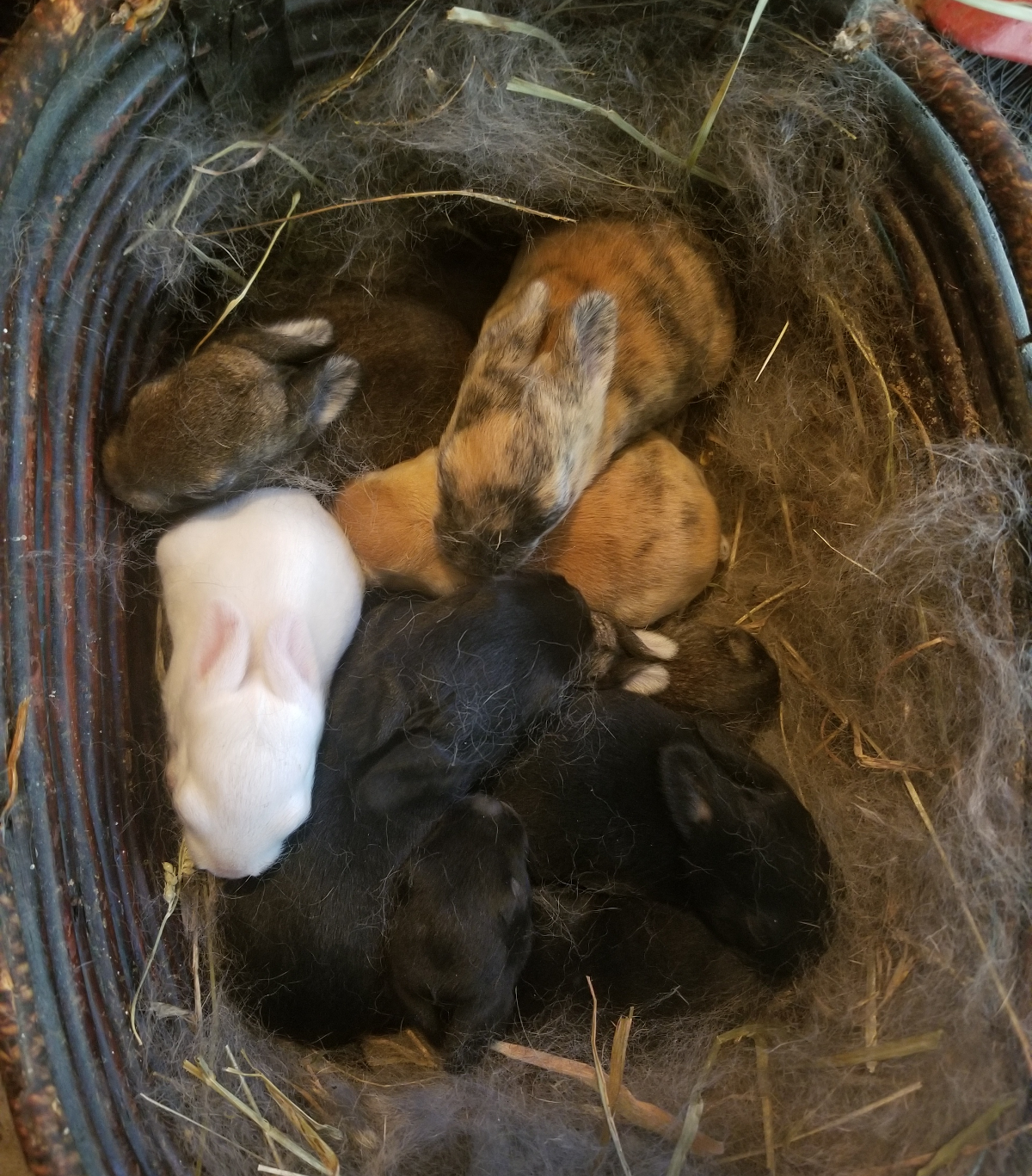
They’re right on time for opening up their eyes.
There’s three rabbits we’re considering keeping from this litter. Both harlequins and this exceptionally chunky black kit. He’s literally heads bigger than the rest of the litter.

The rest are very middle of the pack, including the other castor, the two smaller blacks and the white kit. They’re all adorable, though.
Then there’s the runty one. It’s so small it’s been getting bullied away from its food.

About half the litter was like this after the first couple days. Dehydrated, shaky, underfed. A few didn’t make it, including this one, one of the harlequins and the white one. When a bunny doesn’t get enough to eat, it falls behind and will probably NEVER get enough to eat without intervention. So we started force nursing.
This is where you take the mother rabbit and lay her on your lap on her back, and place the babies on her tummy. Through this method they get rabbits milk to drink straight from the tap without competition. It’s more reliable than bottle feeding which often ends poorly for a host of reasons. Most of them quickly recovered – except for this one. This one is still getting daily feedings separate from the rest of the litter.

Dinner time!
The expectation is that once its eyes are open and it starts sampling solid food it will start to catch up… Until then it’s just one high maintenance kit.
Lastly, a picture of Donut, our valiant mom.

What a good first time mom.
Cozy Cockerels
CW: harvesting animals
This spring we hatched out a few dozen chicks. And when you hatch out a few dozen chicks, it is inevitable you will get some roosters.
We hatched out these chicks with the intention of testing our roosters genetics. And in about a month the ladies should start laying and I will finally know – does my rooster carry one, two, or NO copies of the blue egg laying gene? I bought these chicks as “purebred” wheaten ameraucana chickens. When they arrived, there were issues, not the least of which is that one of the hens started lay BROWN eggs, which mans she carried NO copies of the blue egg gene. Given that these birds are supposed to lay blue eggs, and blue is a simple dominant, there’s a real chance that the rooster could carry any mix of blue egg genes too. That’s a problem. Purebred Ameraucanas are not only supposed to be blue egg layers, they’re supposed to all have two copies of the blue egg gene so that every Ameraucana lays blue eggs every time.
So we hatched out a group of chicks from brown eggs and one group from blue. If our rooster produces any brown egg laying chicks, we know that he carries only one blue egg gene. If he can’t produce any blue egg laying chicks from the brown eggs he has NO blue egg laying genes and needs immediate replacement. If every chick lays blue eggs, he has two copies and is a good to keep long term. The chicks are still only 14 weeks old, so we have some time still on that. About a month, I suspect.
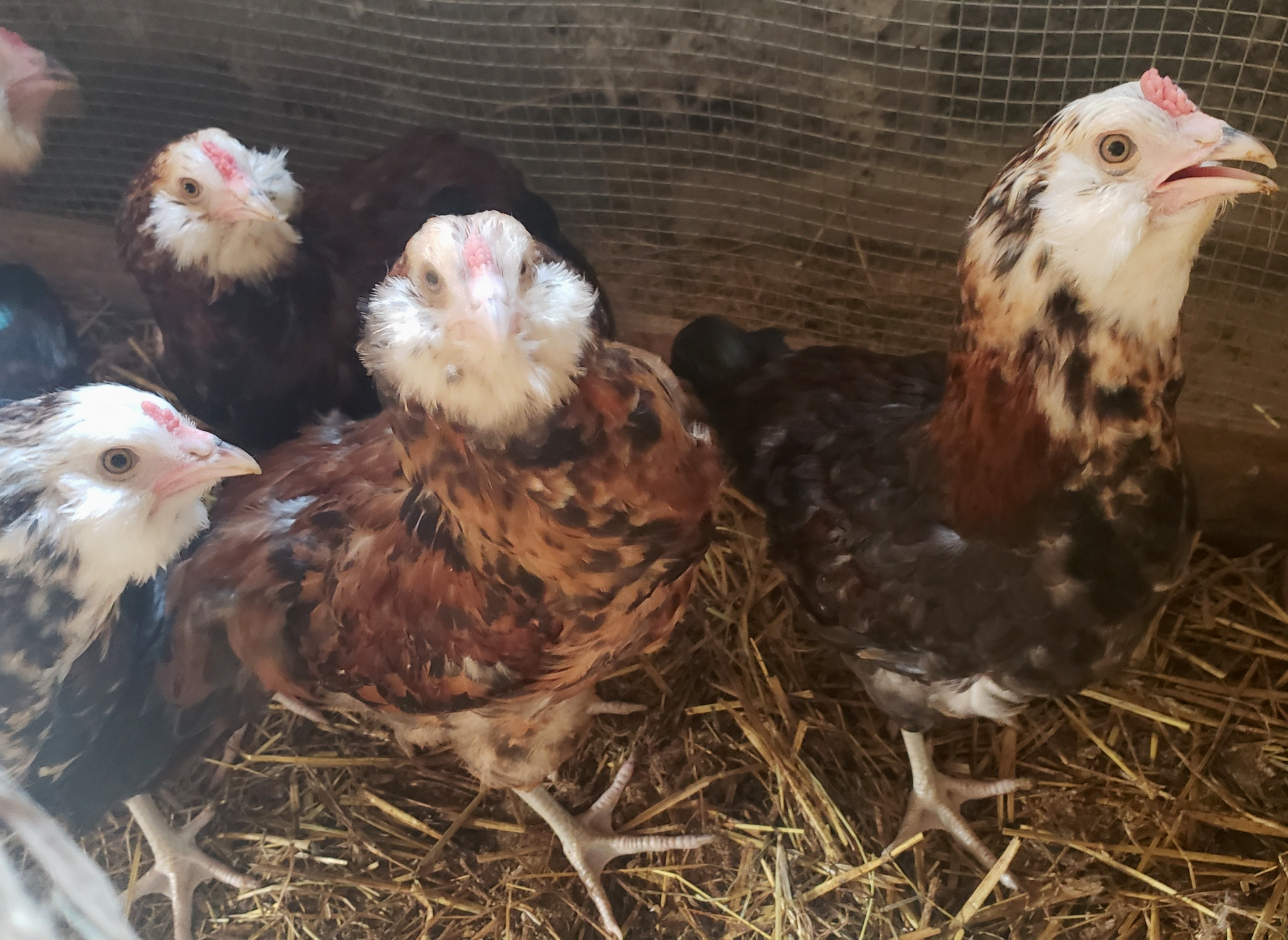
But these boys… Oh boy. When you start to get several cockerels (roosters under a year) in one place at one time, all growing up together, they get a little noisy. The first crow was weak, warbly, and barely heard at 10 weeks.
Then by 12 weeks we had two crowing. And they would go back and forth. A decision was made to eat them ASAP. We can’t have that much noise. So we set about putting together our new chicken plucker I got for Yule this year from my MIL. She’s a wonderful lady who helps enable my animal habits with really nice equipment. Each year I try to limit my requests to one large item and always get more than I expect. This year is was a full Yardbird chicken plucker.
Upon assembly we discovered missing parts, which the Yardbird facility immediately shipped out. But they got caught up in COVID delays. So they finally arrived this week and we set to work.
After much fiddling, we finally got it running, the hose hooked up, and now at long last we are cockerel free. Instead we have several delicious whole chickens, resting in the fridge, ready to eat once rigor passes.
These are the cleanest plucked chickens we’ve ever had. The plucker did a great job, and it was fast. No more hand plucking! Never ever again if we can avoid it! We did two at a time and it was over lickity split.
The bad news is these chickens are just about the smallest bird this monster of a plucker can manage. These chickens processed out to 2lbs or so each and it still dislocated the occasional ankle or hip joint. It would never handle, say, a quail.
We may end up getting a cordless drill plucker if we do get quail in the future.
Harrowing Harlequins
I’ve been, for some time now, slowly working toward tricolor standard rex rabbits. The trick to this is for some time there were no breeders in Ohio. Now a days there’s a few, all about 4 hours away or more.
So I’ve had to improvise a bit. I’ve been breeding my rexes to various other lines to get the colors and sizes I need.

Mini, and his paler and less robust brother (not pictured), became a solid part of my foundation. He’s a mini rex of course, but a big one and that still got me closer to where I want to be.
Then I got a New Zealand Red I named “Cherry”. Cherry, as it turned out was carrying a recessive rex gene. I bred her to Minis brother and got a doe rabbit we’ve creatively dubbed Stripes. Mini and a new zealand white gave us a rabbit we’ve dubbed Tilty for his one lopsided ear. Both are harlequin colored but nothing like what we really wanted through appearance and are slated for immediate replacement ASAP. We don’t try to hard with the names of temporary rabbits. But when I bred Cherry to Porter, my lovely castor rex buck with just the thickest butt you’ve ever seen, I discovered something interesting.
Cherry was carrying a recessive Rex gene. Half her kits in her next litter came out rex furred. And they were out of Porter – a purebred Rex. Since rex is a simple recessive gene, she had to be carrying a copy. She was pedigreed, so it must have been at least 4 generations back that it was bred in, but there it was.

The frontmost and backmost rabbits in this picture have Rex type fur, while the two on the right in the middle have normal type fur.
We kept a big, rex furred doe from the litter and for a long time now she’s been adamantly refusing to let herself be bred. She would stick her butt to the ground and growl at the bucks. She’s over a year old now and hasn’t had a litter despite several breeding attempts, mostly with the mini rex. Until today.
Today our lovely lady gave birth to ELEVEN kits!
And as I examined them and went to take pictures I noticed something.

Is that a smudge I spy on that little bunny’s thigh? (And shoulders?)
Why yes, it was! In fact three of the eleven babies were sporting handsome spots on their sides, showing me their harlequin colors. Compared to the other two, that first one looks quite plain and boring!
The exciting news about these bunnies is that both parents were completely rex furred. Which means these babies will be too. Which means, at long last, I have rex furred harlequins in my keep. I was fully expecting more castors and otters from this mix.
Because of the New Zealand Red from grandma and mini size on the buck, these rabbits are still a few generations away from being able to say “These are truly rex”. But it should be an easy transition from here. I just need to get some typey broken rex rabbits into my herd, breed up in size, and tricolor standard rex are on the way!
Midsummer photo dump

Queen Annes Lace. (Wild carrot, not to be mistaken for the very scary water hemlock that grows on the other side of the lawn and kills you.)

Some of the last of the black raspberries ripening. They’re almost all done.

Butterfly Weed living up to its name and producing lots of flowers. over 6′ tall and the cones of flowers are like 4″-8″.

Our first bean flower. This one is Dragon Langerie Bush Bean. They’ve been OK, these are our first bush beans ever. The Tavera bush beans weren’t very good as almost none of the seeds came up. Major disappointment.

Daylillies that grow in our yard and are super pretty. I love the layered look.

Little baby blue hubbard squash. We have about 10 this size out there. Time will tell if they are pollinated properly or not.

Radish seed pods. We let a bunch of them go to seed so we can save the seeds from them. Once they’re dry on the plant they get picked, husked, dried a bit more then stored for the future. A lot of our plants are open pollinated so we can do that with them. This is one of our most consistent plants every year. They’re amazing.

French breakfast radishes, ready to be eaten any time now.

Fernleaf dill, threatening to flower. Very soft and nice.
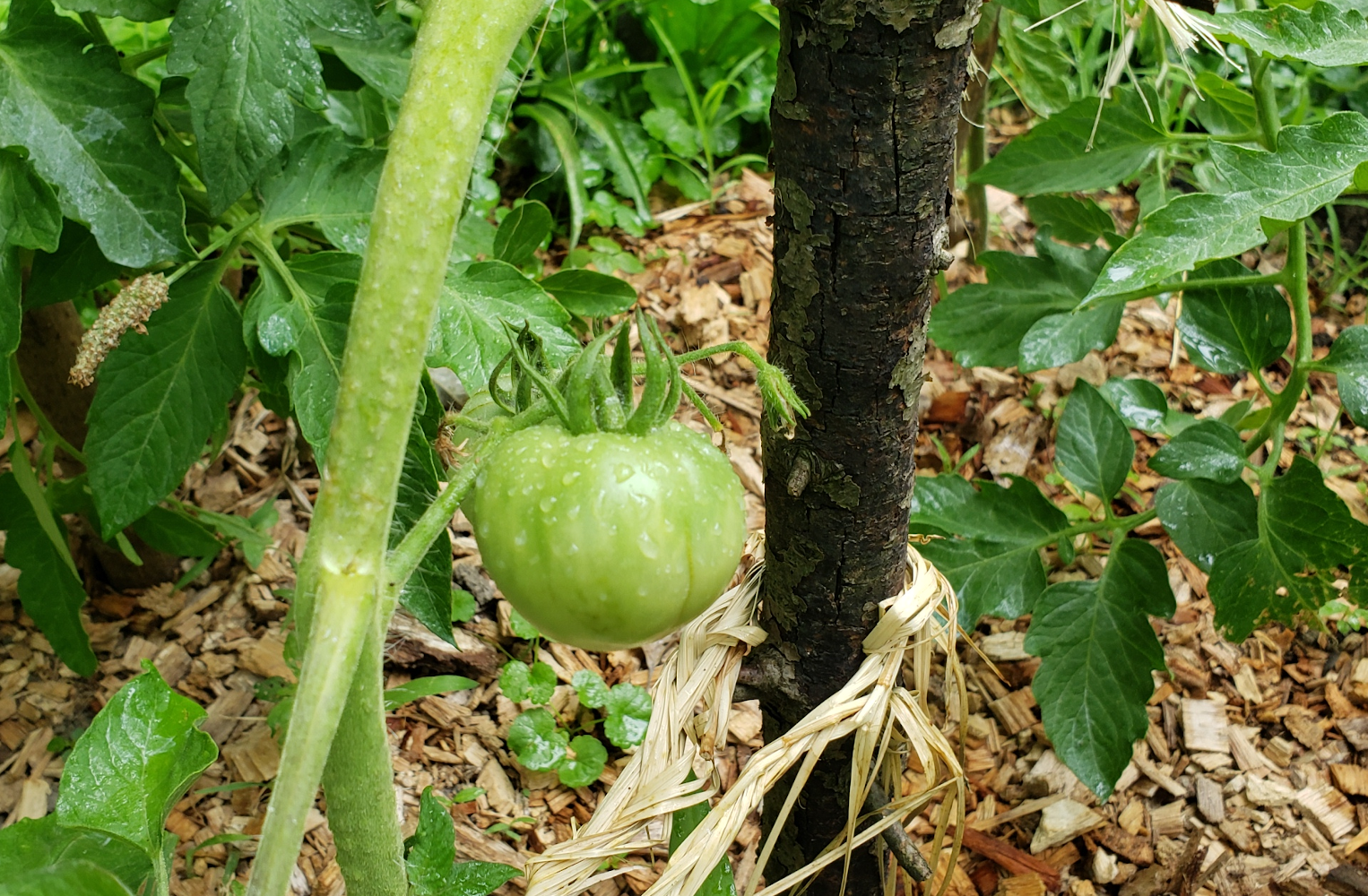
Slicer tomatoes. Still small, about half the size of the pastes. These are even more more expensive than the Plum Regals and only half of them came up. But they have been very disease resistant and positive otherwise.
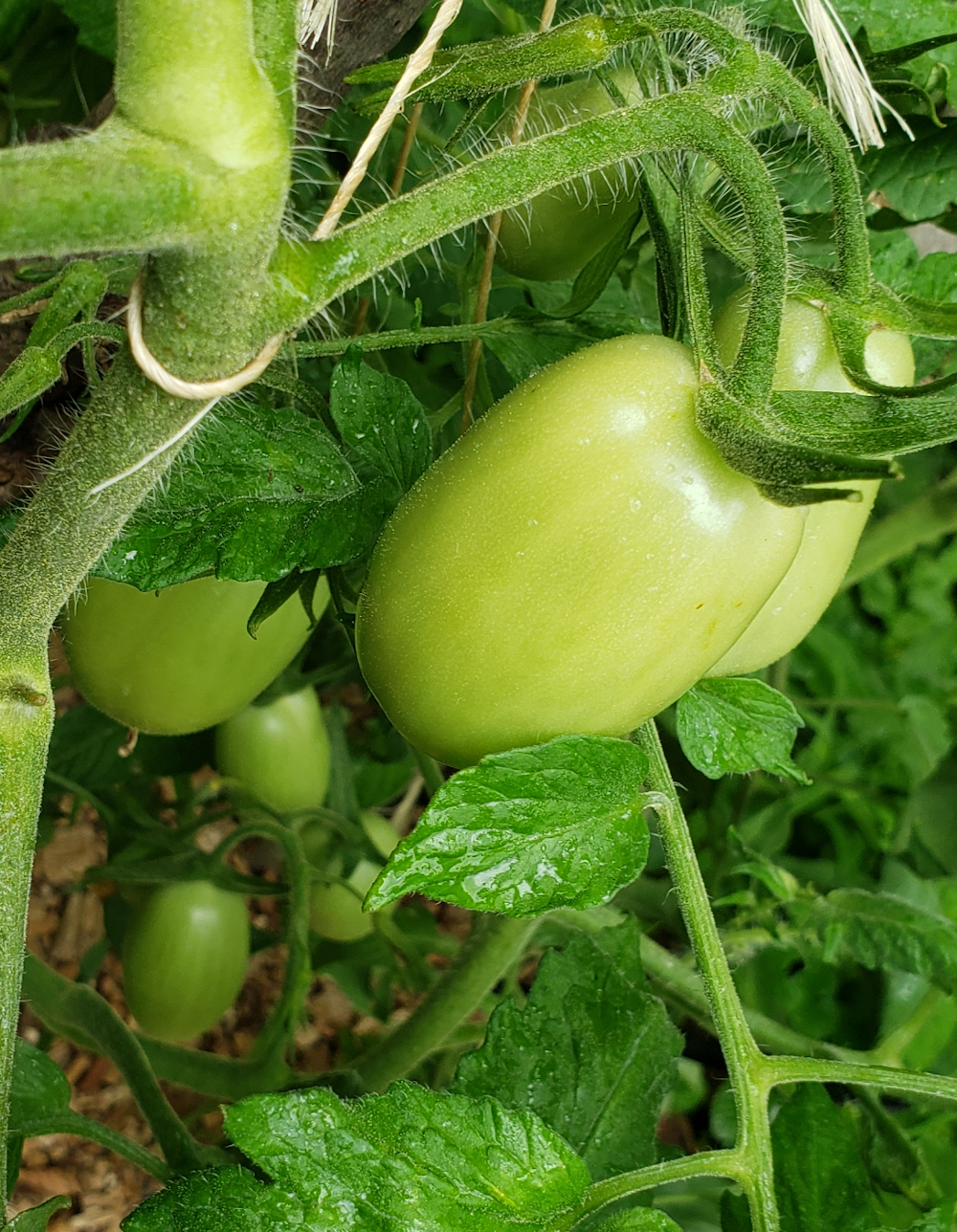
Paste tomatoes, for canning and making tomato sauce for pasta and pizza. Coming in strong. This is a new variety for me (Plum Regal) and they’re doing really well. They’re expensive but I’m probably going to do them again in the future. No disease! All my previous paste tomatoes had serious fungal disease problems but these ones are very resistant!

Cascasdia sugar snap peas. We’re on the last flush of peas but they’re still going fairly well and we’re getting a good number every day. They’re supposed to be a dwarf variety (2-3ft) but they grew to about 4′.

Skinny cayenne peppers. Almost all our peppers are under ripe still.

Very productive jalapeno plants, doing really well.

The squash/beans garden. It consumes all. That’s a 15’x3′ garden bed. The squash has extended its vines WELL past the boundaries on all sides.

Itty bitty habeneros. The hottest peppers we’re growing.
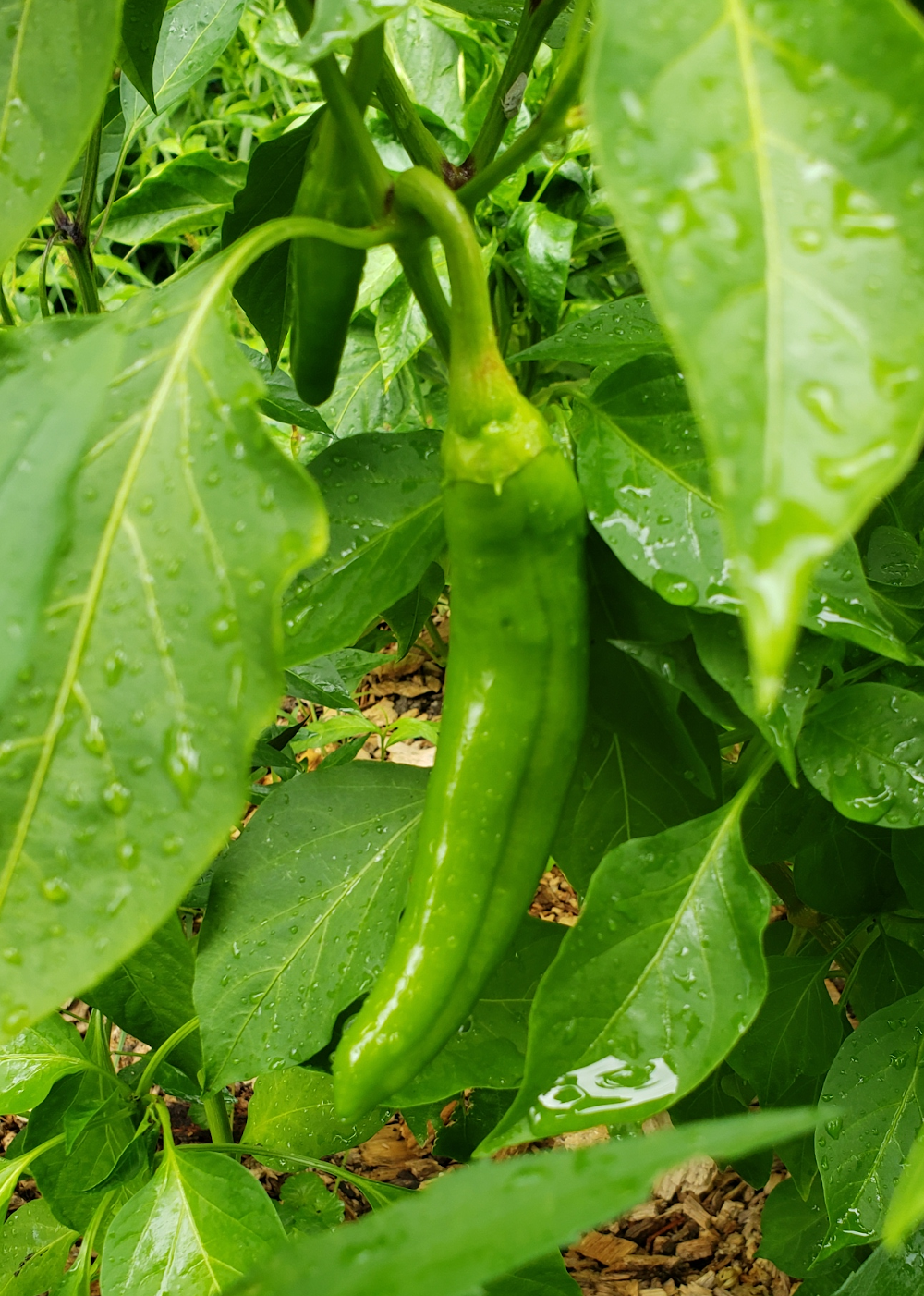
Anaheims, a medium hot pepper that grows big.
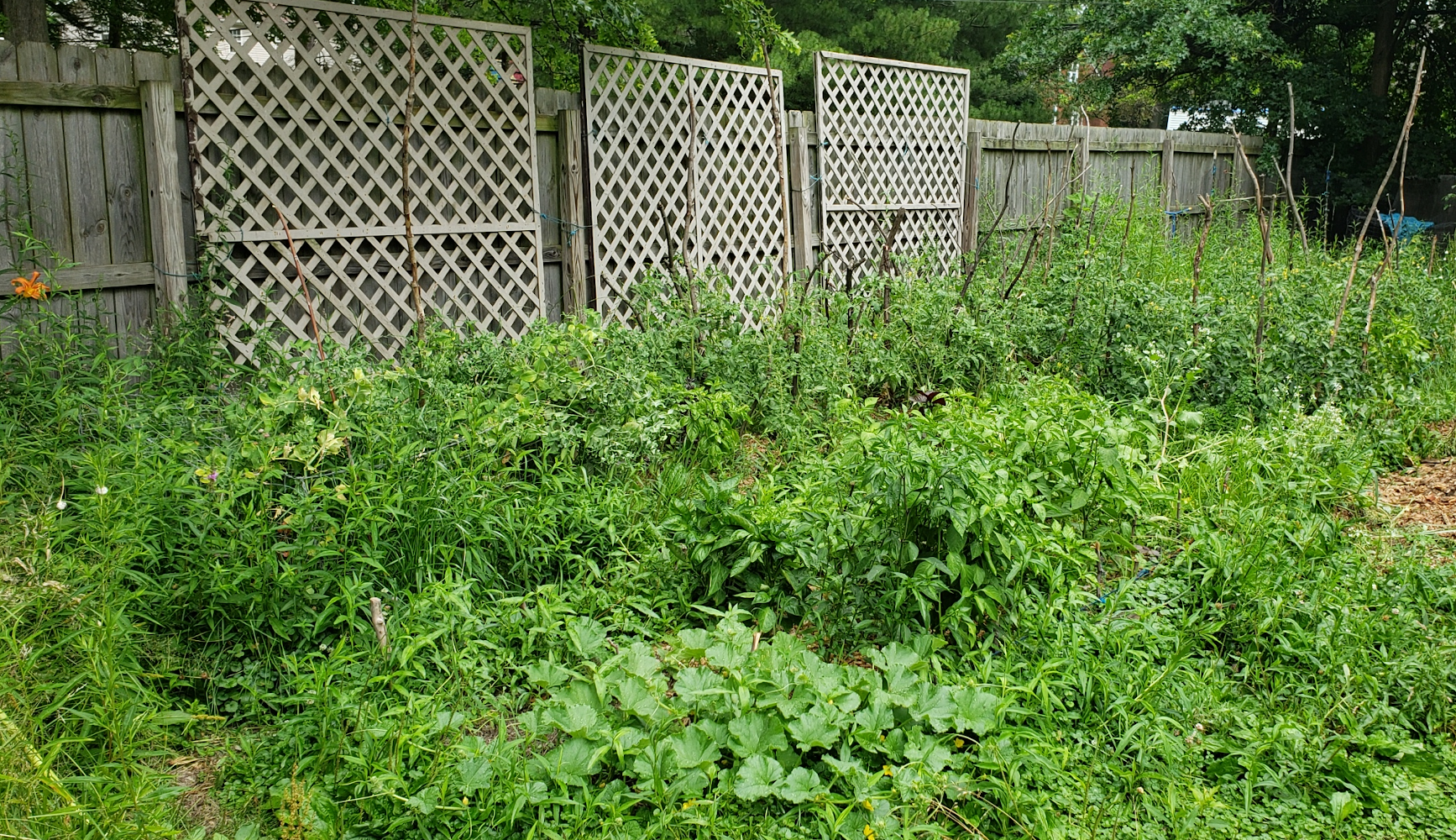
The main garden. A little overgrown but doing really well. Things are really starting to explode!
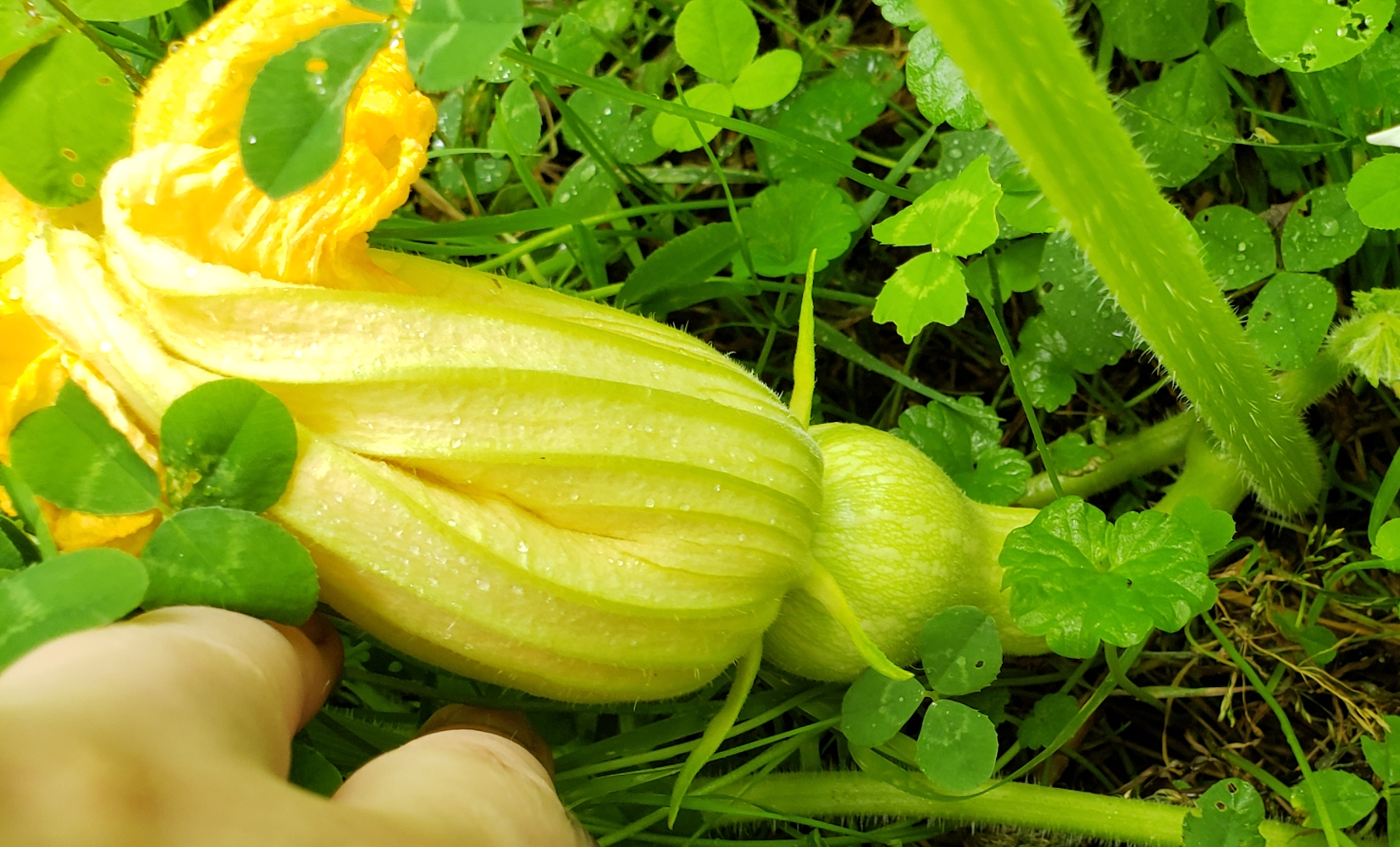
Brulee butternut squash, an “advanced” variant of honeynut that just isn’t doing very well for me. They’re supposed to be better but I like them less as half as many sprouted and they’re not fruiting as fast. But time will tell if they grow more lbs of food. Both honey nut and brulee are very new squash types.

Honey nut butter nut squash. These lil squashes are gonna get about 1-2lbs. Personal pan squashes with a really high sugar content. Sweeter than pie pumpkins.
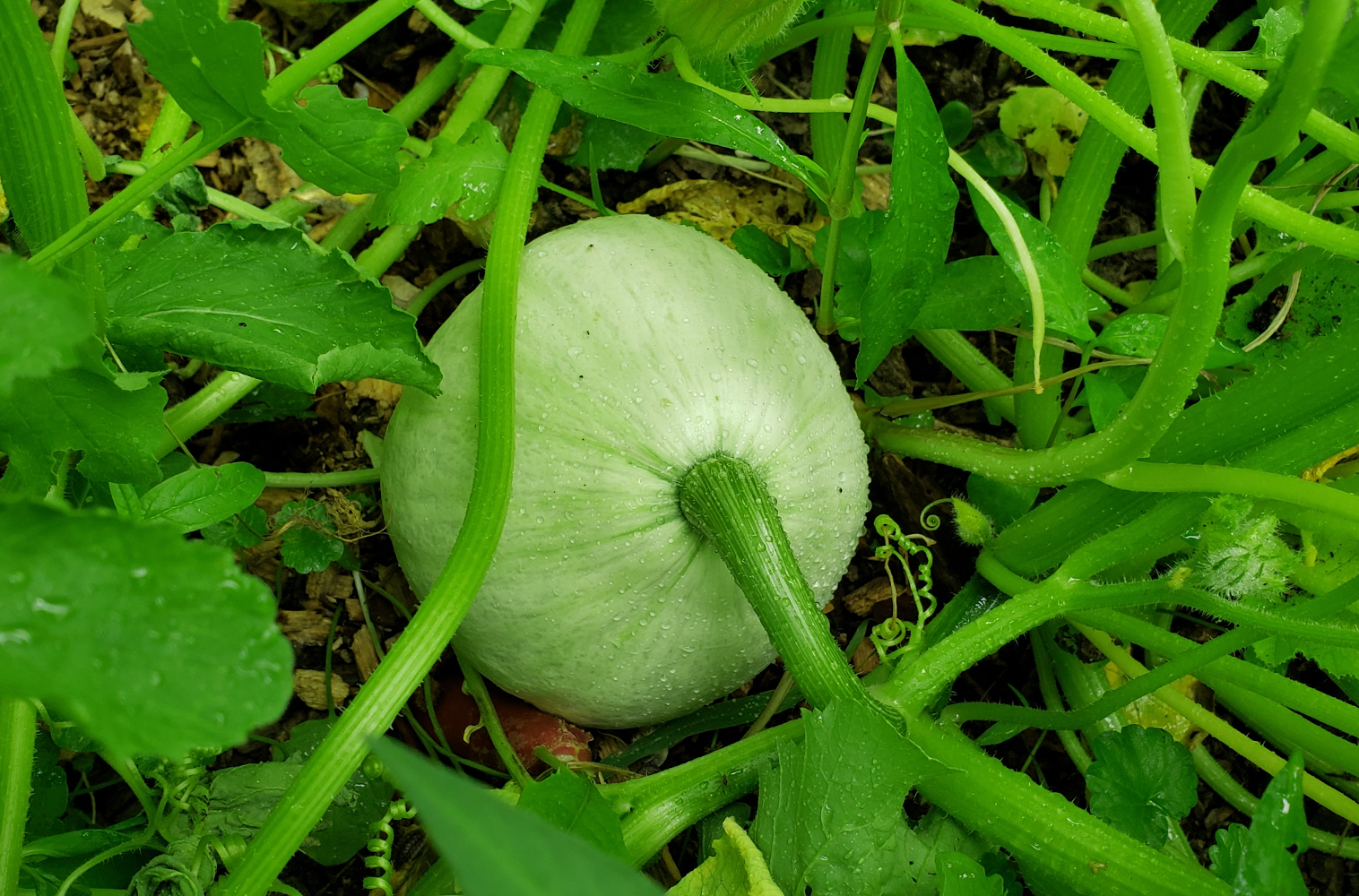
B I G baby blue hubbard. Just starting to get its blue color but bigger than a coconut already. It’ll be about 5lbs full grown. Which is tiny compared to normal hubbards that get to be like 20lbs.

The chicks! Only 12 weeks but they’re huge!
A Little Behind
Everything has been in a flux this year. Joy and sorrow in close succession. One day things will go very well, the next the dreaded raccoons will return. One day someone will say something monumentally foolish and fill me with dread and the next I will feel a lot of love and gratitude.
One example of flux this year was the weather. This was an extremely cold spring. The reason being the activity of the sun. The suns activity influences weather on earth and we’re in a period of extreme inactivity. In fact, we’ve been in a low point for sun activity for a little while now. Unlike the last time of such extreme sunspot activity, however, our climate is a bit warmer. So snows in late June are unlikely and we’re unlikely to see the famine they saw that year… At least, not until the sun acts back up and we all dry out like a raisin.
As if to prove the point that it’s not all about the sun spots this week has been in the mid 80’s, dry and sunny. This after weeks of rain and even snow might technically balance us out. Average temperatures for the month are supposed to be in the 60’s. The second week of this very month saw three snowfalls. That’s the sixth most snowy may on record ever. (Not as impressive as our near yearly setting of record high months, mind you, but impressive none the less.) I have to keep reminding myself “Getting the garden in two weeks after the last snow fall IS a reasonable time frame!”… But on the calendar of the year this should have been done nearly a month ago.



We’ve installed new hardware in the chicken coop. A thick wooden post secures the pop door and chains through loops with latches secures the nest boxes. Every time the raccoons come we secure things more, but they’re clever. We’ve lost 3 hens this year.
We’ve also been cleaning animal skulls lately. We’ve had a rabbit who was not a very good mother lose most of her kits. This isn’t uncommon – I know this is something that can happen. So for Yule one of the things I asked for was a dermastid beetle colony. Dermastid – or flesh eating – beetles are used in taxidermy for cleaning bones. I was graciously purchased one by G. I’m lucky to have such an understanding partner and they’ve brought me a lot of excitement and joy. I’ve been raising up this colony out for a couple months now and I recently set them upon the skulls of some of our rabbits, one skull from an 11 week old fryer, and a few from the failing litter.
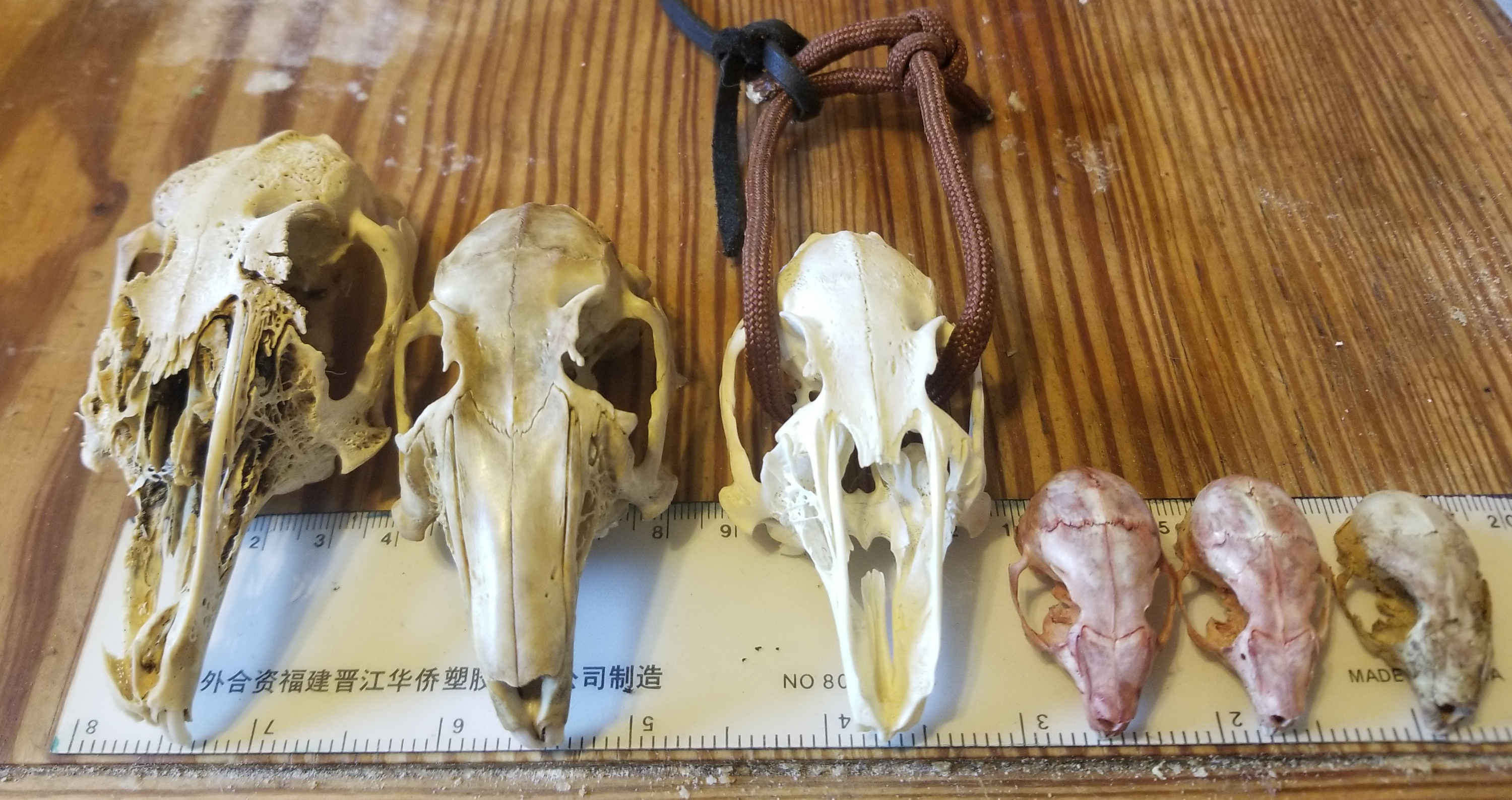
Left to right, a 20 week(ish) skull found in the compost last year, an 11 week skull cleaned by beetles, a 10 week(ish) skull found in the compost four years ago fashioned into a charm, two 4 day kit skulls and one two day kit skull. Ruler is in inches on the close side.
Cleaning the skulls so the beetles can work is tricky. You have to remove as much soft tissue as possible before putting it in. The rule of thumb is “If you touch it and it wiggles still, cut it off.” This means everything from the tongue, soft pallet, eyeballs, brain, etc. I’ve been butchering rabbits for years now and have never experienced anything quite as visceral as cleaning a skull for dermastid beetles before. It’s definitely not for the faint of heart. Turns out D is an old hand at this sort of thing though. He did research on rats eyes for diabetes and learned to extract the eyes and later the retinas with a scalpel. Taking that a bit further to other areas of the skull was a simple extension. He does the bulky parts of the cleaning now – skin, eyes, mouth – and then hand the skulls to me where I extract the brain and more delicate soft tissues with a pair of forceps tweezers. On the baby skulls the bone is so delicate it feels thin like paper.
The beetles then did their jobs admirably. I’m glad to have them and equally glad to have G – the sort of partner who is willing to buy his lady flesh eating beetles for the holidays. The goal is to cast these skulls in resin forms or seal them for jewelry. On this homestead we strive to use every part of the animals we raise. Every time we lost a kit it felt like such a failure. At most the best we could do would be throw the bodies to the birds. Most of the time we composted them. Not only was it a loss of life but a pointless one at that. Now we have at least some use for them. We’ll obviously only take the ones that can’t survive. Even these kits were given a fighting chance – days of trying to force nurse them with mom on her back to no avail. The milk just wasn’t coming in. It’s still sad. But this gives them a little more purpose to their short lives than to simply die and not be honored in any way.
So life is trucking along. And I’m excited to finally have plants going into the ground! Maybe later I will be able to share not just the fruits of our.. Well… fruits. But also how some of the casting turns out with the skulls.
Chick Day
It’s chick day.

It’s been chick day for a lot of people lately. Did you know that it’s chick season?
Three weeks ago we set 36 eggs. That’s about the limit to what this incubator can handle. We diligently turned eggs. Rotated them by hand 3 or 5 times a day. I developed a technique for it where I would carefully line them up in rows so I could remove an egg or two from one end, roll the entire row as one with both hands like colored pencils, then placing the eggs on the other end. D and G just did them one at a time.

More diligently we watched the incubator temperature as the air temperature fluctuated wildly in our spring weather, some days with a cold draft from the windows, others scorching and warm with 70*F and the windows open. Just a few days ago we had snow on the ground. A week before we had sunshine and were working without our shirts in the back yard. At one point early on it spiked to 103.8 in the incubator, and I thought it was all over but most of the eggs persevered. We had the time to be extra vigilant.
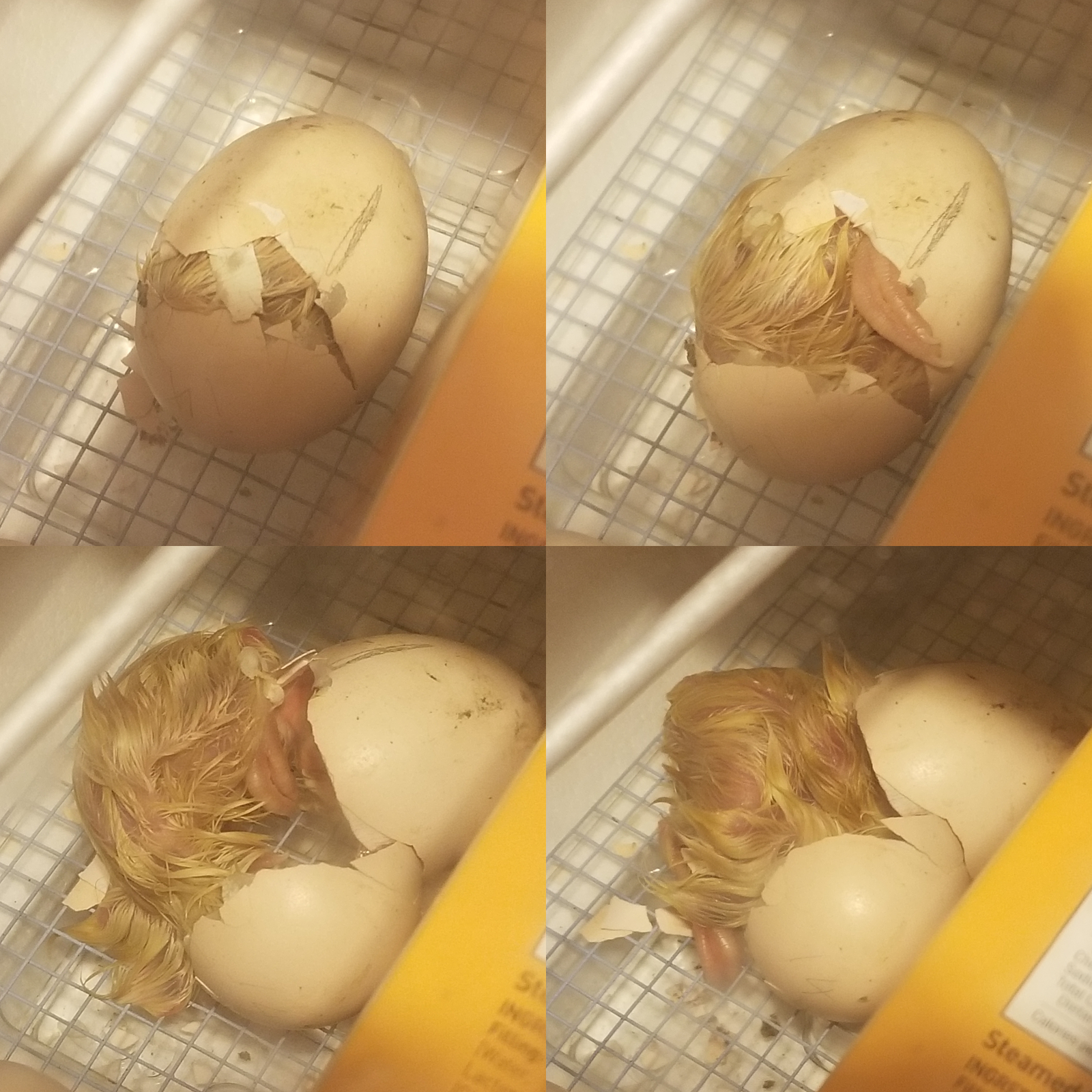
It’s not as though we had anywhere else to be.

Then last night we had a pip. Then this morning we had one wee little chicky. That rapidly turned into five. As of time of writing we have 15? Maybe 16 now, it’s been about 10 minutes since I last checked and at least one started zipping.
Yes. It’s 16 now.
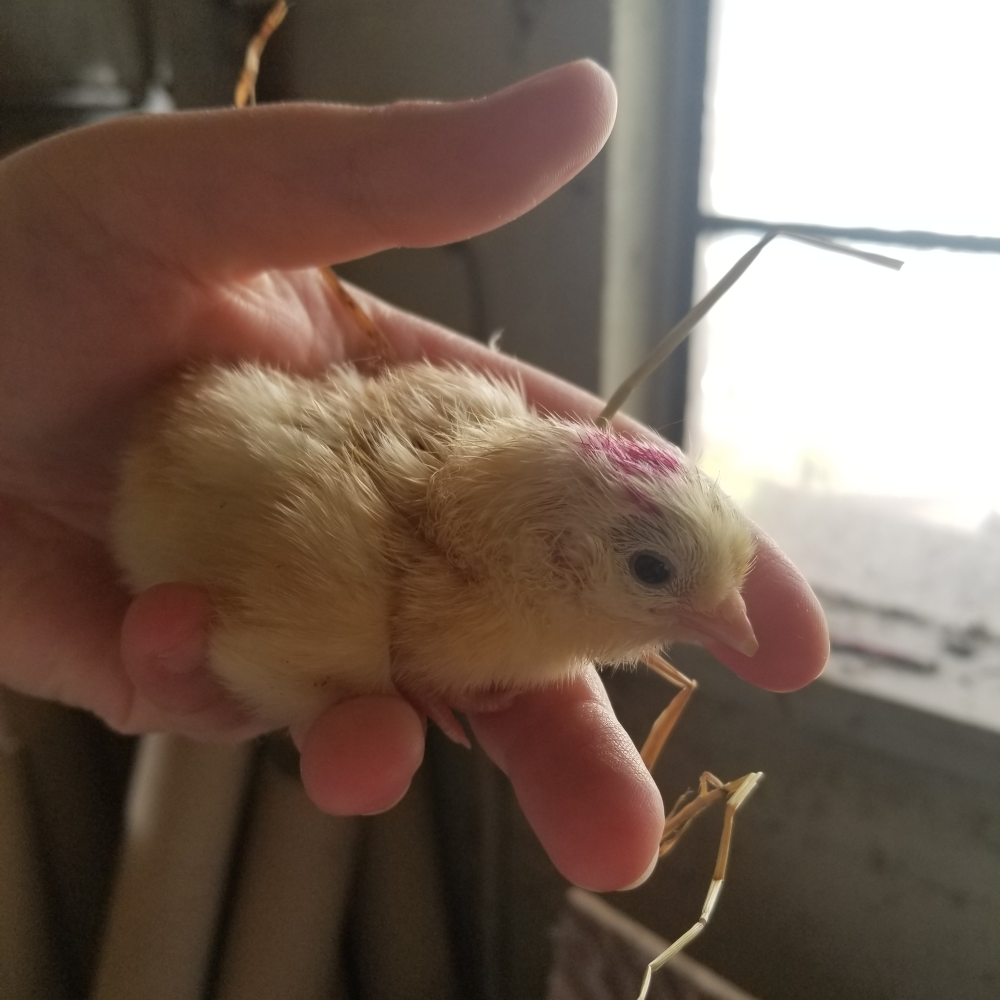
Of course, this meant that the TSC chicks from some weeks ago needed new digs. But the egg chicks aren’t big enough to go in with the flock. So they still have to stay in the garage, just in a 4×4 cage not a 2×3 cage.

The cornish crosses could move out. They’re big enough to hold their own against the adults.

The space seems welcome but none of them are happy to have lost their heat lamp. They loved lounging under it. They’re puffing themselves up without it. They will adjust.
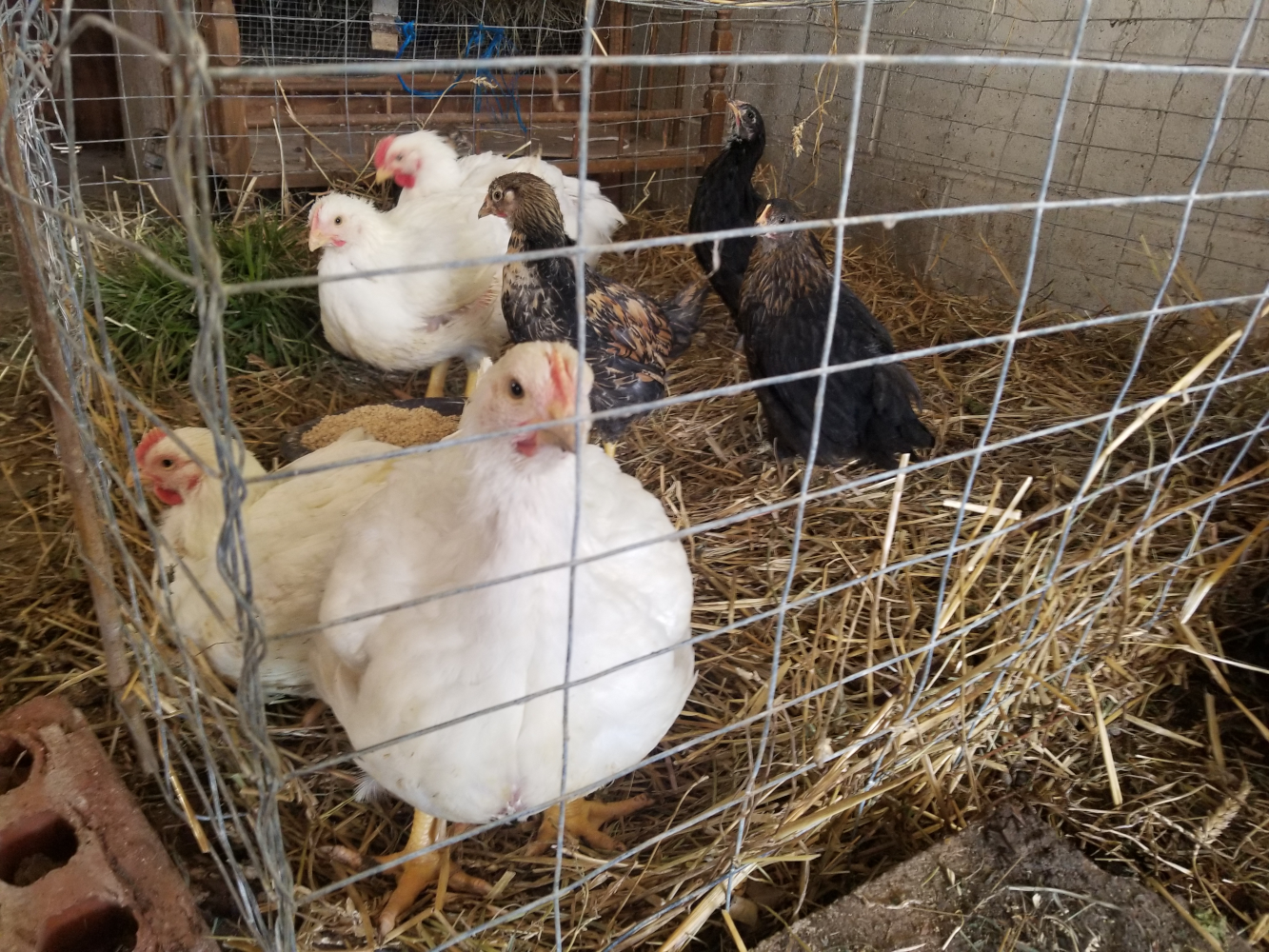
Heat lamps are for wet little chickies that need to get warm, not for fully feathered birds that have been pampered for too long.
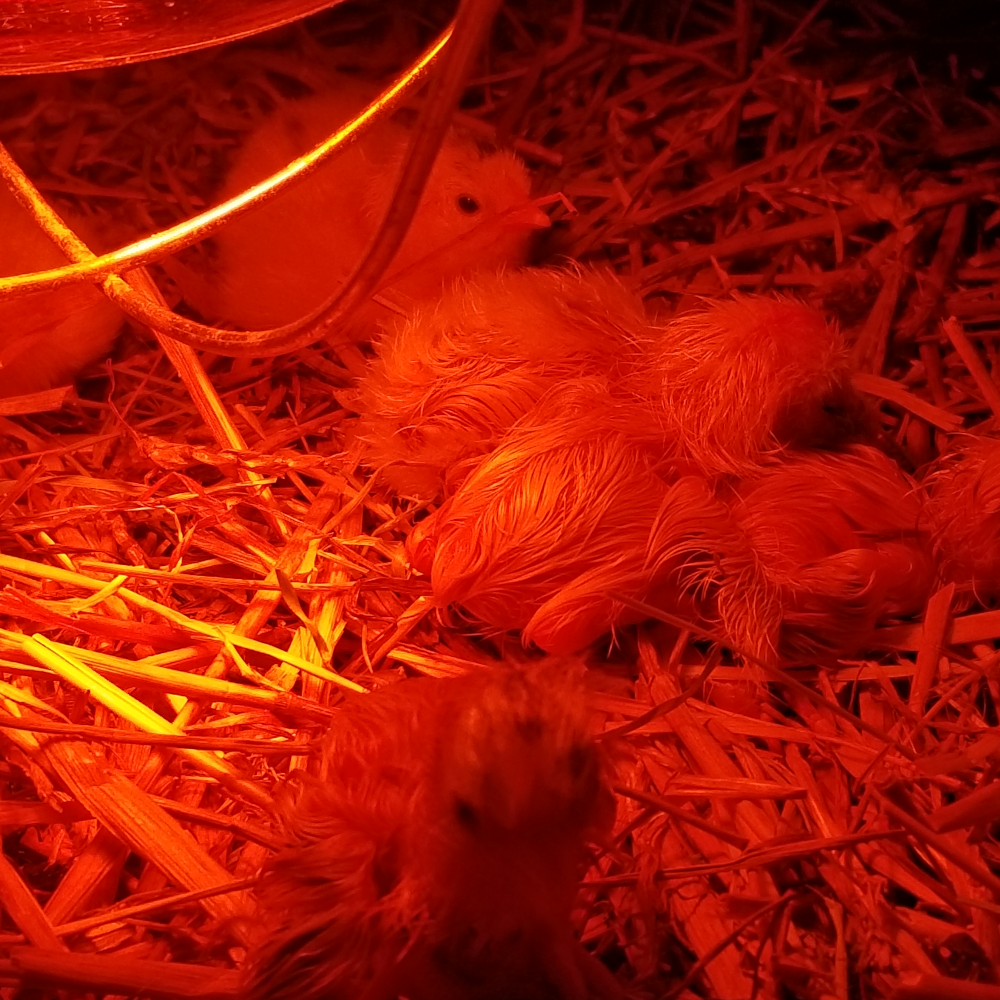
Be safe out there.
Spring pictures
Just a quick picture drop for all of you. Two days ago it was in the 30’s. We have our peas planted but nothing else is outdoors yet.
Marigolds are blooming in the basement, baby blue hubbard squash, tomato plants, peppers and kale, our freshly mulched pathway, a baby from a newer litter, a kit who got a new home, and some of our eggs from this year!
Quarantine’s been hard, G is considered an essential worker. But we have plants and animals growing, we have 36 eggs in the incubator, and life goes on despite it all.
Spring?
Like most of the nation I am stuck inside this week. And the next, for an indefinite time frame.
I’ve received several urgent emails lately about buying breeding rabbits. While I appreciate the business I can’t help but feel as though it is a bit misguided. Even if you got an adult rabbit right now and bred them when you got home, it would still be a month for gestation and then another 2-3 before butcher. By the time you have an edible product we’ll be through this. There’s been a run on chicks at tsc, but that’s also 8 weeks minimum for food. Sixteen weeks for eggs. Similarly, people are planning emergency gardens. My favorite seed company is overwhelmed with orders. Maybe radishes or lettuce will grow in the timeframe we will but not much else.
Not that I mind much. People should be more self sufficient. For 100 years society has run smoothly (according to who you look at or ask) but these things always crop up and when they do the bigger the system the harder it falls. Decentralization is a good thing. But I worry the motivation is temporary.
Of course our garden is well started already. All indoors still. We got snow 2 days ago.
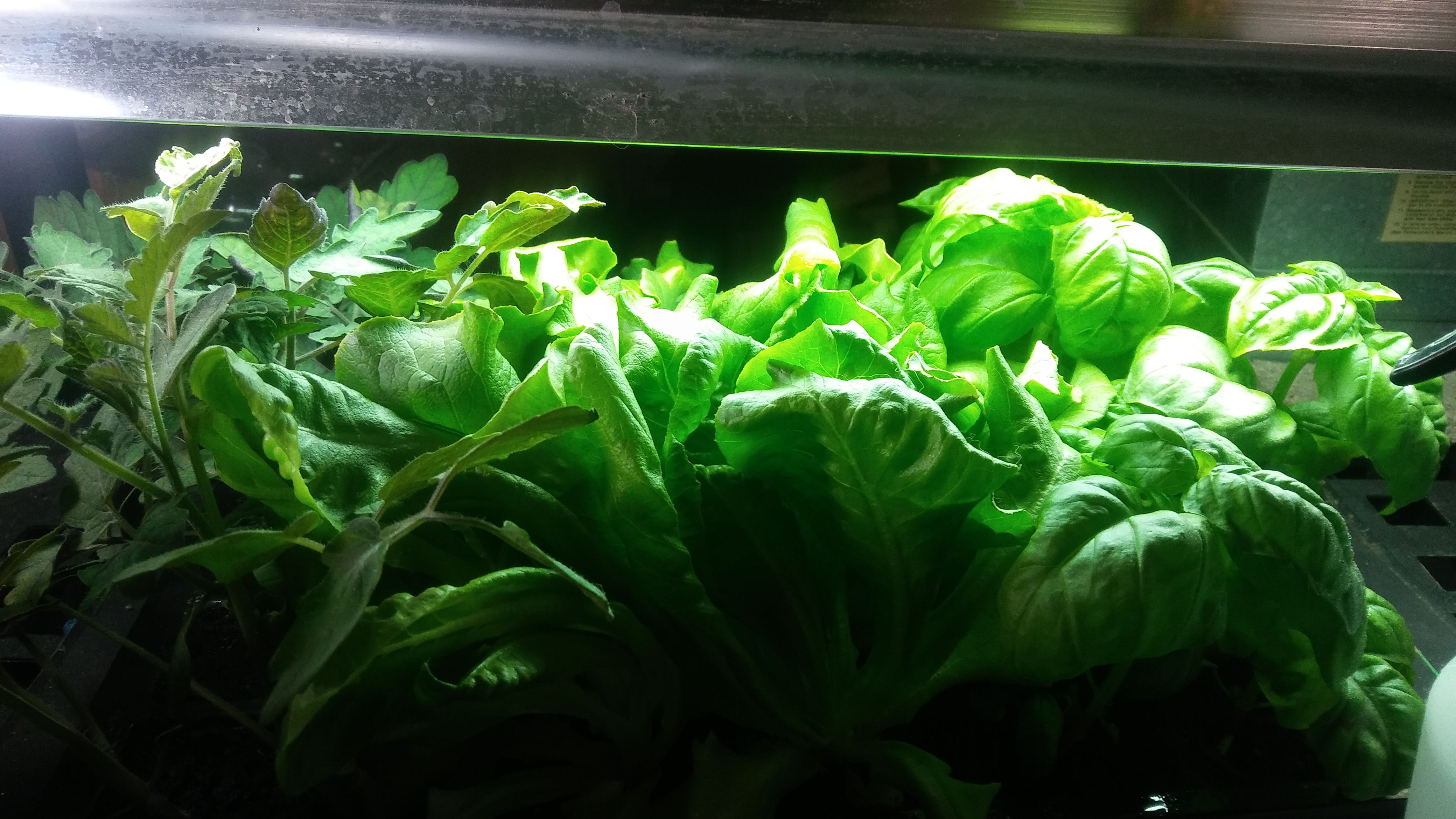


But all of this was started weeks or months ago. These things take time.
And of course the animals carry on without a care in the world. Pandemic or not their priorities remain steady and simple in nature.



At least we’re not going to go hungry. And our family can rely on us for eggs and maybe even meat. But it’s still a bit too cold to do work out. And veggies are a long way off.







